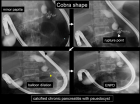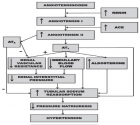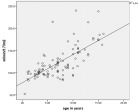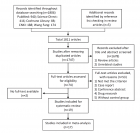Abstract
Review Article
Myeloid Neoplasms: Better Understanding of their Molecular Pathogenesis with Improvised Genomic Testing: A Ray of Hope for Better Clinical Outcomes
Bhardwaj Tina Neelesh* and Phani MN
Published: 31 January, 2024 | Volume 8 - Issue 1 | Pages: 001-007
With the increase in incidence and prevalence of myeloid neoplasms in India, it has become a necessity to understand its molecular mechanisms, acquisition of genomic alterations, and understand its primary and secondary resistance pathways which ultimately impact the decision of therapeutics. The objective of this review is to investigate the molecular aspects of this disease type and identify the biomarkers that help with diagnosis, risk assessment, prognosis, and selecting the best line of treatment for a specific myeloid neoplasm. Advancements and innovations in molecular technologies from simplest Real-Time PCR to high throughput next-generation sequencing have played a vital role in screening the most common mutations and fusions to the novel and rare. Molecular technologies have helped to enumerate the genomic landscape of myeloid malignancies. The understanding of both- the mechanisms and the technology is a strong combination as it has helped revolutionize precision oncology and helped in giving better therapeutic choices with better clinical outcomes. The importance of cellular morphology, clinical symptoms, and molecular pathology in assessing the risk of myeloid malignancies is emphasized and summarized in the review. The review concludes that understanding molecular pathogenesis can be improved by using clinical-pathological-molecular strategies for diagnosis and therapy decision-making.
Read Full Article HTML DOI: 10.29328/journal.jhcr.1001027 Cite this Article Read Full Article PDF
Keywords:
Myeloid; Cellular pathways; Pathogenesis; Molecular technology; Next-generation sequencing
References
- Siegel RL, Miller KD, Wagle NS, Jemal A. Cancer statistics, 2023. CA Cancer J Clin. 2023 Jan;73(1):17-48. doi: 10.3322/caac.21763. PMID: 36633525.
- Murati A, Brecqueville M, Devillier R, Mozziconacci MJ, Gelsi-Boyer V, Birnbaum D. Myeloid malignancies: mutations, models and management. BMC Cancer. 2012 Jul 23; 12:304. doi: 10.1186/1471-2407-12-304. PMID: 22823977; PMCID: PMC3418560.
- Li W. The 5thEdition of the World Health Organization Classification of Hematolymphoid Tumors. In: Li W, editor. Leukemia [Internet]. Brisbane (AU): Exon Publications; 2022 Oct 16. Chapter 1. PMID: 36395314.
- Swerdlow SH, Campo E, Pileri SA, Harris NL, Stein H, Siebert R, Advani R, Ghielmini M, Salles GA, Zelenetz AD, Jaffe ES. The 2016 revision of the World Health Organization classification of lymphoid neoplasms. Blood. 2016 May 19;127(20):2375-90. doi: 10.1182/blood-2016-01-643569. Epub 2016 Mar 15. PMID: 26980727; PMCID: PMC4874220.
- Arber DA, Orazi A, Hasserjian RP, Borowitz MJ, Calvo KR, et al. International Consensus Classification of Myeloid Neoplasms and Acute Leukemias: integrating morphologic, clinical, and genomic data. Blood. 2022 Sep 15;140(11):1200-1228. doi: 10.1182/blood.2022015850. PMID: 35767897; PMCID: PMC9479031.
- Olson OC, Kang YA, Passegué E. Normal Hematopoiesis Is a Balancing Act of Self-Renewal and Regeneration. Cold Spring Harb Perspect Med. 2020 Dec 1;10(12):a035519. doi: 10.1101/cshperspect.a035519. PMID: 31988205; PMCID: PMC7706583.
- Bozic I, Antal T, Ohtsuki H, Carter H, Kim D, Chen S, Karchin R, Kinzler KW, Vogelstein B, Nowak MA. Accumulation of driver and passenger mutations during tumor progression. Proc Natl Acad Sci U S A. 2010 Oct 26;107(43):18545-50. doi: 10.1073/pnas.1010978107. Epub 2010 Sep 27. PMID: 20876136; PMCID: PMC2972991.
- Gao Y, Jia M, Mao Y, Cai H, Jiang X, Cao X, Zhou D, Li J. Distinct Mutation Landscapes Between Acute Myeloid Leukemia with Myelodysplasia-Related Changes and De Novo Acute Myeloid Leukemia. American Journal of Clinical Pathology. 2021; 157. https://doi.org/10.1093/ajcp/aqab172
- Papaemmanuil E, Gerstung M, Malcovati L, Tauro S, Gundem G, et al. Chronic Myeloid Disorders Working Group of the International Cancer Genome Consortium. Clinical and biological implications of driver mutations in myelodysplastic syndromes. Blood. 2013 Nov 21;122(22):3616-27; quiz 3699. doi: 10.1182/blood-2013-08-518886. Epub 2013 Sep 12. PMID: 24030381; PMCID: PMC3837510.
- Ashok V, Ranganathan R, Chander S, Damodar S, Bhat S, S NK, A SK, Jadav SS, Rajashekaraiah M, T S S. Comparison of Diagnostic Yield of a FISH Panel Against Conventional Cytogenetic Studies for Hematological Malignancies: A South Indian Referral Laboratory Analysis of 201 Cases. Asian Pac J Cancer Prev. 2017 Dec 29;18(12):3457-3464. doi: 10.22034/APJCP.2017.18.12.3457. PMID: 29286619; PMCID: PMC5980910.
- Ikbal Atli E, Gurkan H, Onur Kirkizlar H, Atli E, Demir S, Yalcintepe S, Kalkan R, Demir AM. Pros and Cons for Fluorescent in SituHybridization, Karyotyping and Next Generation Sequencing for Diagnosis and Follow-up of Multiple Myeloma. Balkan J Med Genet. 2021 Mar 23;23(2):59-64. doi: 10.2478/bjmg-2020-0020. PMID: 33816073; PMCID: PMC8009570.
- Boscaro E, Urbino I, Catania FM, Arrigo G, Secreto C, Olivi M, D'Ardia S, Frairia C, Giai V, Freilone R, Ferrero D, Audisio E, Cerrano M. Modern Risk Stratification of Acute Myeloid Leukemia in 2023: Integrating Established and Emerging Prognostic Factors. Cancers (Basel). 2023 Jul 6;15(13):3512. doi: 10.3390/cancers15133512. PMID: 37444622; PMCID: PMC10340624.
- El Hussein S, Loghavi S. The Impact of Clonal Hierarchy and Heterogeneity on Phenotypic Manifestations of Myelodysplastic Neoplasms. Cancers (Basel). 2022 Nov 19;14(22):5690. doi: 10.3390/cancers14225690. PMID: 36428782; PMCID: PMC9688198.
- Lachowiez CA, Long N, Saultz J, Gandhi A, Newell LF, Hayes-Lattin B, Maziarz RT, Leonard J, Bottomly D, McWeeney S, Dunlap J, Press R, Meyers G, Swords R, Cook RJ, Tyner JW, Druker BJ, Traer E. Comparison and validation of the 2022 European LeukemiaNet guidelines in acute myeloid leukemia. Blood Adv. 2023 May 9;7(9):1899-1909. doi: 10.1182/bloodadvances.2022009010. PMID: 36441905; PMCID: PMC10172873.
- Mrózek K, Kohlschmidt J, Blachly JS, Nicolet D, Carroll AJ, Archer KJ, Mims AS, Larkin KT, Orwick S, Oakes CC, Kolitz JE, Powell BL, Blum WG, Marcucci G, Baer MR, Uy GL, Stock W, Byrd JC, Eisfeld AK. Outcome prediction by the 2022 European LeukemiaNet genetic-risk classification for adults with acute myeloid leukemia: An Alliance study. Leukemia. 2023 Apr;37(4):788-798. doi: 10.1038/s41375-023-01846-8. Epub 2023 Feb 23. PMID: 36823396; PMCID: PMC10079544.
- Tran TB, Siddon AJ. Molecular findings in myeloid neoplasms. Int J Lab Hematol. 2023 Aug;45(4):442-448. doi: 10.1111/ijlh.14118. Epub 2023 Jun 21. PMID: 37345257.
- Gillis NK, Ball M, Zhang Q, Ma Z, Zhao Y, Yoder SJ, Balasis ME, Mesa TE, Sallman DA, Lancet JE, Komrokji RS, List AF, McLeod HL, Alsina M, Baz R, Shain KH, Rollison DE, Padron E. Clonal haemopoiesis and therapy-related myeloid malignancies in elderly patients: a proof-of-concept, case-control study. Lancet Oncol. 2017 Jan;18(1):112-121. doi: 10.1016/S1470-2045(16)30627-1. Epub 2016 Dec 4. PMID: 27927582; PMCID: PMC7771361.
- Haider M, Duncavage EJ, Afaneh KF, Bejar R, List AF. New Insight Into the Biology, Risk Stratification, and Targeted Treatment of Myelodysplastic Syndromes. Am Soc Clin Oncol Educ Book. 2017; 37:480-494. doi: 10.1200/EDBK_175397. PMID: 28561687.
- Reed SC, Croessmann S, Park BH. CHIP Happens: Clonal Hematopoiesis of Indeterminate Potential and Its Relationship to Solid Tumors. Clin Cancer Res. 2023 Apr 14;29(8):1403-1411. doi: 10.1158/1078-0432.CCR-22-2598. PMID: 36454121; PMCID: PMC10106364.
- Ortmann CA, Dorsheimer L, Abou-El-Ardat K, Hoffrichter J, Assmus B, Bonig H, Scholz A, Pfeifer H, Martin H, Schmid T, Brüne B, Scheich S, Steffen B, Riemann J, Hermann S, Dukat A, Bug G, Brandts CH, Wagner S, Serve H, Rieger MA. Functional Dominance of CHIP-Mutated Hematopoietic Stem Cells in Patients Undergoing Autologous Transplantation. Cell Rep. 2019 May 14;27(7):2022-2028.e3. doi: 10.1016/j.celrep.2019.04.064. PMID: 31091442.
- Azad NA, Shah ZA, Pandith AA, Rasool R, Jeelani S. Real-time quantitative PCR: a reliable molecular diagnostic and follow-up tool for 'minimal residual disease' assessment in chronic myeloid leukemia. Biosci Rep. 2018 Oct 5;38(5):BSR20180974. doi: 10.1042/BSR20180974. PMID: 30054431; PMCID: PMC6172424.
- Green MR, Sambrook J. Polymerase Chain Reaction. Cold Spring Harb Protoc. 2019 Jun 3;2019(6). doi: 10.1101/pdb.top095109. PMID: 31160389.
- Emery SL, Erdman DD, Bowen MD, Newton BR, Winchell JM, Meyer RF, Tong S, Cook BT, Holloway BP, McCaustland KA, Rota PA, Bankamp B, Lowe LE, Ksiazek TG, Bellini WJ, Anderson LJ. Real-time reverse transcription-polymerase chain reaction assay for SARS-associated coronavirus. Emerg Infect Dis. 2004 Feb;10(2):311-6. doi: 10.3201/eid1002.030759. PMID: 15030703; PMCID: PMC3322901.
- Shahjahani M, Hadad EH, Azizidoost S, Nezhad KC, Shahrabi S. Complex karyotype in myelodysplastic syndromes: Diagnostic procedure and prognostic susceptibility. Oncol Rev. 2019 Feb 4;13(1):389. doi: 10.4081/oncol.2019.389. PMID: 30858933; PMCID: PMC6379782.
- Stölzel F, Mohr B, Kramer M, Oelschlägel U, Bochtler T, Berdel WE, Kaufmann M, Baldus CD, Schäfer-Eckart K, Stuhlmann R, Einsele H, Krause SW, Serve H, Hänel M, Herbst R, Neubauer A, Sohlbach K, Mayer J, Middeke JM, Platzbecker U, Schaich M, Krämer A, Röllig C, Schetelig J, Bornhäuser M, Ehninger G. Karyotype complexity and prognosis in acute myeloid leukemia. Blood Cancer J. 2016 Jan 15;6(1):e386. doi: 10.1038/bcj.2015.114. PMID: 26771812; PMCID: PMC4742631.
- Bishop R. Applications of fluorescence in situ hybridization (FISH) in detecting genetic aberrations of medical significance. Bioscience Horizons: The International Journal of Student Research. 2010; 3(1): 85-95. https://doi.org/10.1093/biohorizons/hzq009
- Chrzanowska NM, Kowalewski J, Lewandowska MA. Use of Fluorescence In Situ Hybridization (FISH) in Diagnosis and Tailored Therapies in Solid Tumors. Molecules. 2020 Apr 17;25(8):1864. doi: 10.3390/molecules25081864. PMID: 32316657; PMCID: PMC7221545.
- Yoshida MC. Recent advances in fluorescence in situ hybridization. J Radiat Res. 1992 Mar;33 Suppl:54-60. doi: 10.1269/jrr.33.supplement_54. PMID: 1507179.
- Bacher U, Shumilov E, Flach J, Porret N, Joncourt R, Wiedemann G, Fiedler M, Novak U, Amstutz U, Pabst T. Challenges in the introduction of next-generation sequencing (NGS) for diagnostics of myeloid malignancies into clinical routine use. Blood Cancer J. 2018 Nov 12;8(11):113. doi: 10.1038/s41408-018-0148-6. PMID: 30420667; PMCID: PMC6232163.
- Novak ER, Deshpande A, Finlay D, Mason JR, Deshpande AJ, Adams PD, Li S. Detection of TP53 Mutation in Acute Myeloid Leukemia by RT-PCR-Based Sanger Sequencing. Methods Mol Biol. 2023; 2594:87-95. doi: 10.1007/978-1-0716-2815-7_7. PMID: 36264490.
- Genomics FL, Mobley I. A brief history of Next Generation Sequencing (NGS). Front Line Genomics. 2021. https://frontlinegenomics.com/a-brief-history-of-next-generation-sequencing-ngs/
- Kahraman CY, Sincan G, Tatar A. Next-Generation Sequencing Panel Test in Myeloid Neoplasms and Evaluation with the Clinical Results. Eurasian J Med. 2022 Jun;54(2):181-185. doi: 10.5152/eurasianjmed.2022.21102. PMID: 35703527; PMCID: PMC9634881.
- Khan I, Eklund EE, Gartel AL. Therapeutic Vulnerabilities of Transcription Factors in AML. Mol Cancer Ther. 2021 Feb;20(2):229-237. doi: 10.1158/1535-7163.MCT-20-0115. Epub 2020 Nov 6. PMID: 33158995; PMCID: PMC9052200.
- Huang HT, Figueroa ME. Epigenetic deregulation in myeloid malignancies. Blood. 2021 Aug 26;138(8):613-624. doi: 10.1182/blood.2019004262. PMID: 34436526.
- Alhmoud JF, Mustafa AG, Malki MI. Targeting DNA Repair Pathways in Hematological Malignancies. Int J Mol Sci. 2020 Oct 6;21(19):7365. doi: 10.3390/ijms21197365. PMID: 33036137; PMCID: PMC7582413.
- Alhmoud JF, Woolley JF, Al Moustafa AE, Malki MI. DNA Damage/Repair Management in Cancers. Cancers (Basel). 2020 Apr 23;12(4):1050. doi: 10.3390/cancers12041050. PMID: 32340362; PMCID: PMC7226105.
- Chatterjee N, Walker GC. Mechanisms of DNA damage, repair, and mutagenesis. Environ Mol Mutagen. 2017 Jun;58(5):235-263. doi: 10.1002/em.22087. Epub 2017 May 9. PMID: 28485537; PMCID: PMC5474181.
- Bonner EA, Lee SC. Therapeutic Targeting of RNA Splicing in Cancer. Genes (Basel). 2023 Jun 29;14(7):1378. doi: 10.3390/genes14071378. PMID: 37510283; PMCID: PMC10379351.
- Sotillo E, Barrett DM, Black KL, Bagashev A, Oldridge D, Wu G, Sussman R, Lanauze C, Ruella M, Gazzara MR, Martinez NM, Harrington CT, Chung EY, Perazzelli J, Hofmann TJ, Maude SL, Raman P, Barrera A, Gill S, Lacey SF, Melenhorst JJ, Allman D, Jacoby E, Fry T, Mackall C, Barash Y, Lynch KW, Maris JM, Grupp SA, Thomas-Tikhonenko A. Convergence of Acquired Mutations and Alternative Splicing of CD19 Enables Resistance to CART-19 Immunotherapy. Cancer Discov. 2015 Dec;5(12):1282-95. doi: 10.1158/2159-8290.CD-15-1020. Epub 2015 Oct 29. PMID: 26516065; PMCID: PMC4670800.
- Bachegowda L, Gligich O, Mantzaris I, Schinke C, Wyville D, Carrillo T, Braunschweig I, Steidl U, Verma A. Signal transduction inhibitors in treatment of myelodysplastic syndromes. J Hematol Oncol. 2013 Jul 10;6:50. doi: 10.1186/1756-8722-6-50. PMID: 23841999; PMCID: PMC3716523.
- Williamson EA, Boswell HS. Signal transduction during myeloid cell differentiation. Curr Opin Hematol. 1995 Jan;2(1):29-40. doi: 10.1097/00062752-199502010-00005. PMID: 9371969.
- AACR Project GENIE Consortium. AACR Project GENIE: Powering Precision Medicine through an International Consortium. Cancer Discov. 2017 Aug;7(8):818-831. doi: 10.1158/2159-8290.CD-17-0151. Epub 2017 Jun 1. PMID: 28572459; PMCID: PMC5611790.
- Blood Cancer Statistics. LLS. 2023. https://www.lls.org/facts-and-statistics/facts-and-statistics-overview
- Cohesin Causes Replicative DNA Damage by Trapping DNA Topological Stress. 2023. https://pubmed.ncbi.nlm.nih.gov/32259483/
- Detection of TP53 Mutation in Acute Myeloid Leukemia by RT-PCR-Based Sanger Sequencing. 2024. from https://pubmed.ncbi.nlm.nih.gov/36264490/
- The consequences of cohesin mutations in myeloid malignancies. 2023. https://www.frontiersin.org/articles/10.3389/fmolb.2023.1319804/full
- High-throughput mutagenesis identifies mutations and RNA-binding proteins controlling CD19 splicing and CART-19 therapy resistance. 2023. https://pubmed.ncbi.nlm.nih.gov/36138008/
- Metabolic reprogramming and epigenetic modifications in cancer: From the impacts and mechanisms to the treatment potential. Experimental & Molecular Medicine. 2023. https://www.nature.com/articles/s12276-023-01020-1
- Polymerase Chain Reaction (PCR). 2024. https://www.ncbi.nlm.nih.gov/probe/docs/techpcr/
- Understanding intrinsic hematopoietic stem cell aging. Haematologica. 2023. https://www.haematologica.org/article/view/9473
- Understanding RT-PCR Tests and Results. National Collaborating Centre for Infectious Diseases. 2024. https://nccid.ca/publications/understanding-rt-pcr-tests-and-results/
Figures:
Similar Articles
-
Cytomegalovirus pneumonia and Cryptogenic organizing pneumonia following pediatric stem cell transplantation for leukemiaZühre Kaya*,Tuba Şişmanlar,Ayşe Tana Aslan,Öznur Konuş Boyunağa,Işıl Fidan Balcı,İdil Yenicesu,Ülker Koçak. Cytomegalovirus pneumonia and Cryptogenic organizing pneumonia following pediatric stem cell transplantation for leukemia. . 2017 doi: 10.29328/journal.jhcr.1001003; 1: 014-018
-
Successful management of disseminated Fusarium infection in a patient with acute myeloid leukemiaAlShammasi S,AlNujaidi D,Bakhit K,Algarni A,AlAnazi KA*. Successful management of disseminated Fusarium infection in a patient with acute myeloid leukemia. . 2018 doi: 10.29328/journal.jhcr.1001007; 2: 015-020
-
The beneficial effects of varicella zoster virusKhalid Ahmed Al-Anazi*,Al-Anazi WK,Al-Jasser AM. The beneficial effects of varicella zoster virus. . 2019 doi: 10.29328/journal.jhcr.1001010; 3: 016-049
-
Essential thrombocythemia: Biology, clinical features, thrombotic risk, therapeutic options and outcomeVincenzo Accurso*,Santoro M,Contrino AD,Casimiro P,Raso S,Carlisi M,Sardo M,Perez A,Di Piazza F,Russo A,Siragusa S. Essential thrombocythemia: Biology, clinical features, thrombotic risk, therapeutic options and outcome. . 2019 doi: 10.29328/journal.jhcr.1001012; 3: 053-059
-
Myeloid Neoplasms: Better Understanding of their Molecular Pathogenesis with Improvised Genomic Testing: A Ray of Hope for Better Clinical OutcomesBhardwaj Tina Neelesh*, Phani MN. Myeloid Neoplasms: Better Understanding of their Molecular Pathogenesis with Improvised Genomic Testing: A Ray of Hope for Better Clinical Outcomes. . 2024 doi: 10.29328/journal.jhcr.1001027; 8: 001-007
-
The Outcome of Patients with Leukemia Presenting with Hyperleukocytosis Requiring Leukapheresis. The Experience of King Fahad Specialist Hospital in Dammam, Saudi ArabiaKhalid Ahmed Al-Anazi*, Alsaffar WA, Aljishi FK, Kanfer S, Kalogiannidis P, Alenazi W, Alshammasi Z, Albahrani A, Abduljalil O, Mutahar E, Alwakeel AM, Apostolidis I, Darweesh M, Almokhtar N, Abdulbaqi M, Albanyan O, Alshaibani Z, Raslan H, Aldayel A. The Outcome of Patients with Leukemia Presenting with Hyperleukocytosis Requiring Leukapheresis. The Experience of King Fahad Specialist Hospital in Dammam, Saudi Arabia. . 2024 doi: 10.29328/journal.jhcr.1001028; 8: 008-016
-
Assessment of Redox Patterns at the Transcriptional and Systemic Levels in Newly Diagnosed Acute LeukemiaAna Carolina Agüero Aguilera, María Eugenia Mónaco, Sandra Lazarte, Emilse Ledesma Achem, Natalia Sofía Álvarez Asensio, Magdalena María Terán, Blanca Alicia Issé, Marcela Medina, Cecilia Haro*. Assessment of Redox Patterns at the Transcriptional and Systemic Levels in Newly Diagnosed Acute Leukemia. . 2024 doi: 10.29328/journal.jhcr.1001029; 8: 017-023
Recently Viewed
-
Late discover of a traumatic cardiac injury: Case reportBenlafqih C,Bouhdadi H*,Bakkali A,Rhissassi J,Sayah R,Laaroussi M. Late discover of a traumatic cardiac injury: Case report. J Cardiol Cardiovasc Med. 2019: doi: 10.29328/journal.jccm.1001048; 4: 100-102
-
A two-phase sonographic study among women with infertility who first had normal sonographic findingsKalu Ochie*,Abraham John C. A two-phase sonographic study among women with infertility who first had normal sonographic findings. Clin J Obstet Gynecol. 2022: doi: 10.29328/journal.cjog.1001117; 5: 101-103
-
Sinonasal Myxoma Extending into the Orbit in a 4-Year Old: A Case PresentationJulian A Purrinos*, Ramzi Younis. Sinonasal Myxoma Extending into the Orbit in a 4-Year Old: A Case Presentation. Arch Case Rep. 2024: doi: 10.29328/journal.acr.1001099; 8: 075-077
-
Analysis of Psychological and Physiological Responses to Snoezelen Multisensory StimulationLucia Ludvigh Cintulova,Jerzy Rottermund,Zuzana Budayova. Analysis of Psychological and Physiological Responses to Snoezelen Multisensory Stimulation. J Neurosci Neurol Disord. 2024: doi: 10.29328/journal.jnnd.1001103; 8: 115-125
-
Feature Processing Methods: Recent Advances and Future TrendsShiying Bai,Lufeng Bai*. Feature Processing Methods: Recent Advances and Future Trends. J Clin Med Exp Images. 2025: doi: 10.29328/journal.jcmei.1001035; 9: 010-014
Most Viewed
-
Evaluation of Biostimulants Based on Recovered Protein Hydrolysates from Animal By-products as Plant Growth EnhancersH Pérez-Aguilar*, M Lacruz-Asaro, F Arán-Ais. Evaluation of Biostimulants Based on Recovered Protein Hydrolysates from Animal By-products as Plant Growth Enhancers. J Plant Sci Phytopathol. 2023 doi: 10.29328/journal.jpsp.1001104; 7: 042-047
-
Sinonasal Myxoma Extending into the Orbit in a 4-Year Old: A Case PresentationJulian A Purrinos*, Ramzi Younis. Sinonasal Myxoma Extending into the Orbit in a 4-Year Old: A Case Presentation. Arch Case Rep. 2024 doi: 10.29328/journal.acr.1001099; 8: 075-077
-
Feasibility study of magnetic sensing for detecting single-neuron action potentialsDenis Tonini,Kai Wu,Renata Saha,Jian-Ping Wang*. Feasibility study of magnetic sensing for detecting single-neuron action potentials. Ann Biomed Sci Eng. 2022 doi: 10.29328/journal.abse.1001018; 6: 019-029
-
Pediatric Dysgerminoma: Unveiling a Rare Ovarian TumorFaten Limaiem*, Khalil Saffar, Ahmed Halouani. Pediatric Dysgerminoma: Unveiling a Rare Ovarian Tumor. Arch Case Rep. 2024 doi: 10.29328/journal.acr.1001087; 8: 010-013
-
Physical activity can change the physiological and psychological circumstances during COVID-19 pandemic: A narrative reviewKhashayar Maroufi*. Physical activity can change the physiological and psychological circumstances during COVID-19 pandemic: A narrative review. J Sports Med Ther. 2021 doi: 10.29328/journal.jsmt.1001051; 6: 001-007

HSPI: We're glad you're here. Please click "create a new Query" if you are a new visitor to our website and need further information from us.
If you are already a member of our network and need to keep track of any developments regarding a question you have already submitted, click "take me to my Query."


















































































































































